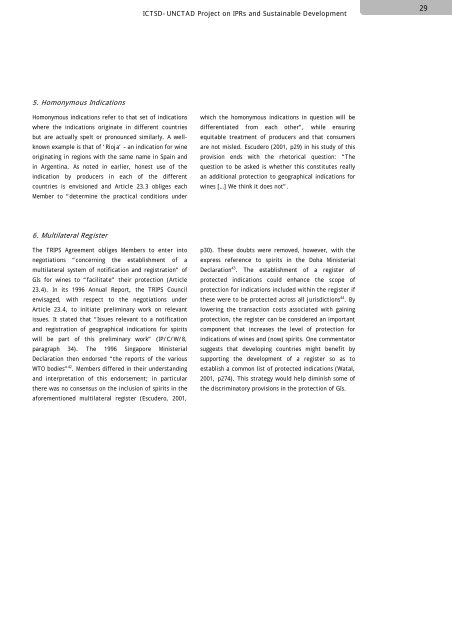28Dwijen Rangnekar - <strong>Geographical</strong> <strong>Indications</strong>Box 5: Unanswered questions on the relationship between trademarks and GIsThe overlap between trademarks and GIs can be encapsulated in the following questions: In what circumstances willa GI take precedence over a trademark, and vice versa? Can there be instances where trademarks and GIs overlapand coexist?Answering these questions requires a reading and interpretation of various articles in the TRIPS Agreement, viz.,Article 22.3 where the basic relationship between GIs and trademarks is expressed and Article 23.2 where thetrademark-GI interface with respect to wines and spirits is enunciated. Articles 24.5 and 24.7, where the exceptionto the previous articles is expressed. Articles 16 and 17 where the scope of protection available to a trademarkholderand relevant exceptions are respectively enunciated. Article 2.1 which brings specific provisions of the ParisConvention to bear on the TRIPS Agreement.At the outset it is useful to remain aware that the exceptions to protection of GIs under Article 24.5 might beexclusively applicable to wines and spirits. For example, Gervais (1998, p135-6), provides an interpretation to thiseffect, while also speculating that a reference to ‘Section’ in the Article could lead to the conclusion that it appliesto Articles 22 and 23. This ambiguity aside, existing legal opinion on the exception varies. Some suggest thattrademarks should rein supreme over GIs, whereas others conclude that a case for invalidating trademarks by latteroccurringGIs is conceivable.In principle, Article 24.5 allows for trademarks that are “identical with, or similar to” GIs to exist if they have beenacquired in good faith, either (a) before the application of these provisions by that Member, or (b) before the GI isprotected in the country of origin. One suggested interpretation of this exception is that prior trademarks cancontinue to exist and may also provide the grounds to invalidate GIs (Grevers, 1999; Harte-Bavendamm, 2000). Theseauthors indicate reason that the ‘right to use’ a trademark – clearly stated in Article 24.5 – conjoined with the scopeof protection of trademarks (Article 16.1), provides the trademark owner the ‘right to exclude’ the latter-granted GI.Moreover, they suggest that Articles 1-12 of the Paris Convention, which embody the principle of ‘first in time, firstin right’ priority as the basis for resolving conflicts between IPRs, lays the foundation for the primacy of trademarksover later GIs. Within this view the only exception is when the trademark misleads the public.No doubt, there are other opinions on this relationship and the lack of clarity within the Agreement itself is thewellspring of divergent views. Grevers (1999) identifies scenarios of the coexistence of trademarks and GIs “withoutlimitation in time and without any other limitation” (p156) and suggests that exceptions to trademark protection(Article 17), where ‘fair use of descriptive terms’ is a stated, might be the legal basis for coexistence.The relationship between trademarks and GIs is complex and the balance attempted by negotiators is tenuous andopen to varied interpretations. WIPO’s Standing Committee on the Law of Trademarks, Industrial Designs and<strong>Geographical</strong> <strong>Indications</strong> has visited this issue on a number of occasions (cf. WIPO – International Bureau, 2000).4.Deceptive <strong>Indications</strong>A range of situations can be identified where indicationsare literally true but nonetheless their use is consideredmisleading. This may be the case with deceptiveindications and/or homonymous indications. Article 22.4makes provisions for protection against deceptiveindications. Gervais (1998, pp126-27) presents ahypothetical case of emigrants from a former imperialcountry having settled in the colony in a region whichthey eventually name as the same name of the region oftheir origin. Naturally, these expatriates could use thesame indication for the same goods. Through Article22.4, producer groups in the ‘original’ region in theimperial country could prohibit use of the indication bythe expatriates.
ICTSD-UNCTAD Project on IPRs and Sustainable Development295. Homonymous <strong>Indications</strong>Homonymous indications refer to that set of indicationswhere the indications originate in different countriesbut are actually spelt or pronounced similarly. A wellknownexample is that of ‘Rioja’ – an indication for wineoriginating in regions with the same name in Spain andin Argentina. As noted in earlier, honest use of theindication by producers in each of the differentcountries is envisioned and Article 23.3 obliges eachMember to “determine the practical conditions underwhich the homonymous indications in question will bedifferentiated from each other”, while ensuringequitable treatment of producers and that consumersare not misled. Escudero (2001, p29) in his study of thisprovision ends with the rhetorical question: “Thequestion to be asked is whether this constitutes reallyan additional protection to geographical indications forwines […] We think it does not”.6. Multilateral RegisterThe TRIPS Agreement obliges Members to enter intonegotiations “concerning the establishment of amultilateral system of notification and registration” ofGIs for wines to “facilitate” their protection (Article23.4). In its 1996 Annual Report, the TRIPS Councilenvisaged, with respect to the negotiations underArticle 23.4, to initiate preliminary work on relevantissues. It stated that “Issues relevant to a notificationand registration of geographical indications for spiritswill be part of this preliminary work” (IP/C/W/8,paragraph 34). The 1996 Singapore MinisterialDeclaration then endorsed “the reports of the variousWTO bodies” 42 . Members differed in their understandingand interpretation of this endorsement; in particularthere was no consensus on the inclusion of spirits in theaforementioned multilateral register (Escudero, 2001,p30). These doubts were removed, however, with theexpress reference to spirits in the Doha MinisterialDeclaration 43 . The establishment of a register ofprotected indications could enhance the scope ofprotection for indications included within the register ifthese were to be protected across all jurisdictions 44 . Bylowering the transaction costs associated with gainingprotection, the register can be considered an importantcomponent that increases the level of protection forindications of wines and (now) spirits. One commentatorsuggests that developing countries might benefit bysupporting the development of a register so as toestablish a common list of protected indications (Watal,2001, p274). This strategy would help diminish some ofthe discriminatory provisions in the protection of GIs.









